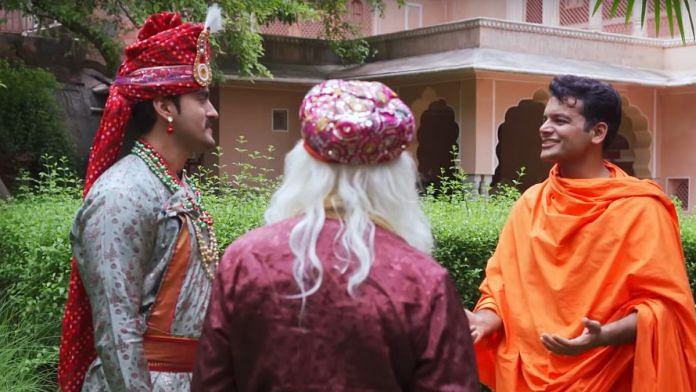Rajasthan is not the first place that comes to mind when you think of Swami Vivekananda. But the monk’s self-actualisation, his signature turban and even his name have their roots in the palace of Khetri’s royal family.
A new 21-minute docu-drama Ajit-Vivek: Tale of a Monk and a King follows the relationship between Vivekananda and Raja Ajit Singh.
The two only met three times over the course of their short lives— they both died at age 39, just over a year apart—but their bond ran deep. The philosopher even called the king his “only friend in this life”.
Singh was the eighth ruler of Khetri between 1870-1901. He was a connoisseur of art and music and even attended Queen Victoria’s diamond jubilee in England in 1897. According to documents and archived letters, they met in 1891,1893, and 1897.
Singh used to send Rs 100 a month to Vivekananda’s mother from 1891 till his death.
The docu-drama highlights an important phase of Swami Vivekananda’s life. It’s Singh who had not only given him the name Vivekananda but also presented him with a turban which became an integral part of his identity. Singh also provided monetary aid to Vivekananda to travel to Chicago for the Parliament of the World’s Religions in 1893.
The Ramakrishna Mission, established by Vivekananda in 1897, was the starting point for the docu-drama’s director Aditya Sangwan. The mission has converted Singh’s palace in Khetri to a Vivekananda Smriti Mandir. The archival material from the mission and the information from the mandir itself form the basis for this relatively unknown story of the philosopher.
Also Read: Swami Vivekananda is not a Sangh Parivar icon. Liberal-progressives allowed his appropriation
‘Complete sainthood’
The docu-drama opens with Vivekananda in Singh’s court. The king calls on a courtesan to sing and the monk gets visibly awkward. He takes his leave, fumbling on his words. It’s clear that he thinks meeting the gaze of a woman is not fit for a man of his position.
But as the woman starts to sing, the monk returns. He thanks the woman for opening his mind. “The veil of ignorance has been lifted,” he says. Now he knows not to make a distinction between man and woman, low and high.
Just when you think this fantastical incident leans too heavily on the drama, Ashok Singh Shekhawat, the chairman of the Vivekananda Sikshan Sansthan, appears on screen. He is one of the figureheads lending his voice to qualify the documentary part of the short film.
This was when Vivekananda achieved “complete sainthood”, he says.
Also Read: The Vivekananda story: ‘India’s secular liberals run away from everything the Sangh touches’
Change in personality
Quirks of a low-budget drama aside, the film seems to completely change a core aspect of Vivekananda’s identity—his inquisitive nature and his penchant for questioning everything.
It’s turned him into an almost caricature-like figure, complete with an ill-fitting turban.
“Theek hai bhai, svikar kiya,” he says without hesitation when the king changes his name from Vividishananda to Vivekananda. He also unquestioningly accepts the turban and the robe the king provides for his journey to Chicago.
But had it not been for the financial support from Singh, he would not have been able to deliver his iconic speech at Chicago—“I am proud to belong to a religion which has taught the world both tolerance and universal acceptance. We believe not only in universal toleration, but we accept all religions as true. I am proud to belong to a nation which has sheltered the persecuted and the refugees of all religions and all nations of the earth.”
It’s impossible to watch the short film and not feel that it’s Khetri and Singh who are the heroes of the story. They’re the monk’s image architects— the philosopher was a wise sage, but the funding, the look, the name, and even the source of his enlightenment came from the king and his land.



